
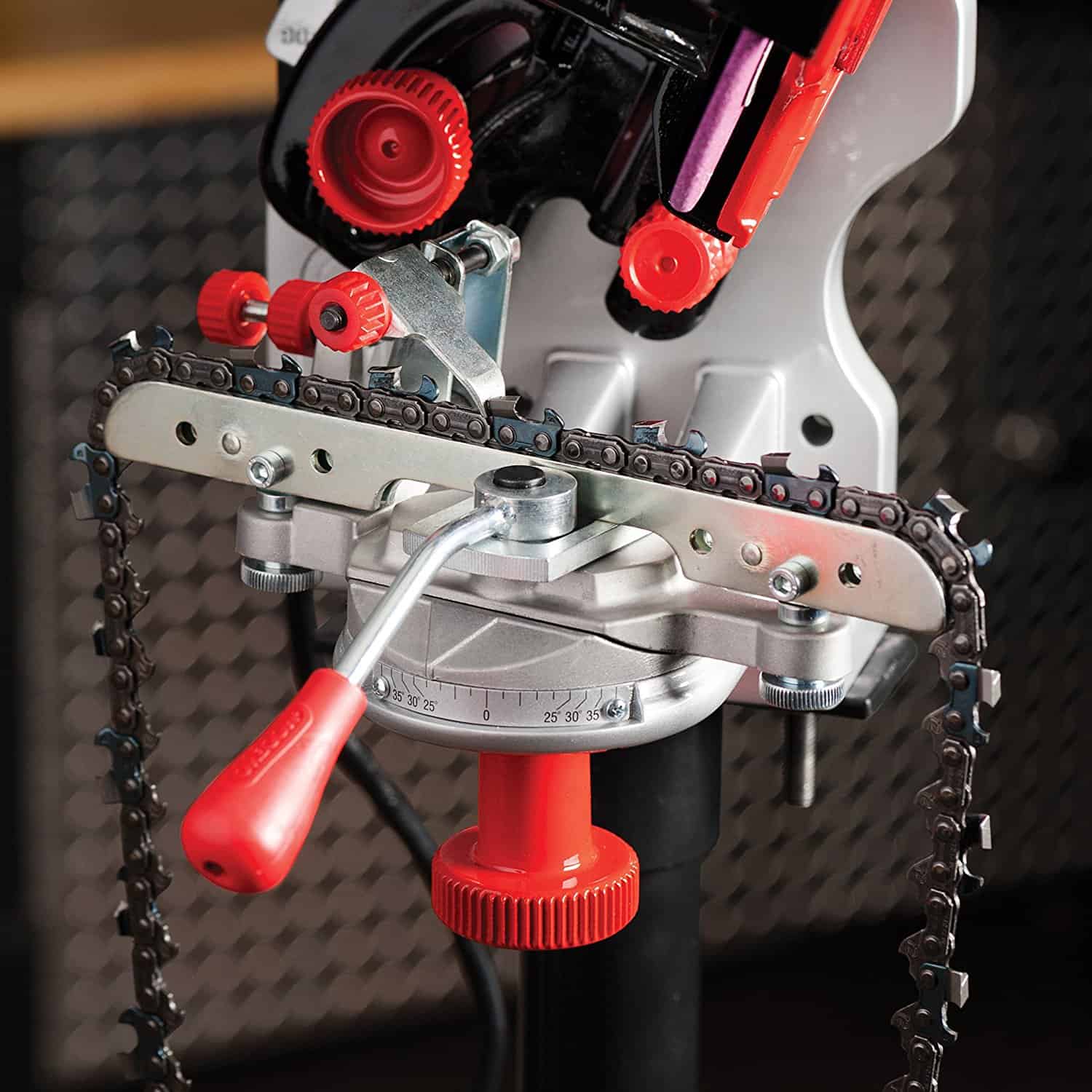
When the chain of your chainsaw wears out, you only have three options: getting a new chain, taking the chain for re-sharpening at your local vendor, or, find yourself the best chainsaw sharpener and do the work yourself.
 Buffalo Electric Chainsaw Sharpener
Buffalo Electric Chainsaw Sharpener
The unit is affordable
Easy to use and cuts each tooth to the same length and angle
Adjustable to fit many chain sizes
Quick and powerful
The power switch is located in an unsafe spot on the machine
The mounting holes are not easily accessible and are not shouldered at the bottom
Some parts are made of poor quality material
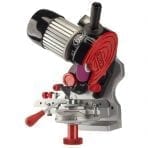 Oregon 410-120 Bench or Wall Mounted Saw Chain Grinder
Oregon 410-120 Bench or Wall Mounted Saw Chain Grinder
Solid construction
Includes 3 grinding wheels
Easy controls for sharpening various chain pitches
Not straight-forward to install
Low-quality packaging
Not portable
Motor moves in only one direction
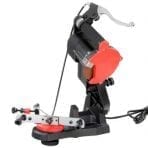 XtremepowerUS 85W Mini
XtremepowerUS 85W Mini
Easy to set up and little assembly needed
Easy to use with good and quick results
Affordable
Easily portable
Kit does not come with mounting bolts and these have to be purchased separately
Not as accurate as other electric models
TruePower 01-0854 Electric Chain Saw
Adjustable to fit all chain sizes to sharpen fast and efficiently.
Quick and easy to set up
Powerful motor
Adjustable to fit all chain sizes
Works fast and efficiently
You’ll have to file the rakers separately with a flat file
Made of cheap material
Only suitable for occasional use
Granberg Bar-Mount Chain Saw Sharpener
Lightweight design with the ability to fit all standard pitch sizes.
Lightweight design
Adjustable to fit all standard pitch sizes
Sharpens teeth and files depth gauges at the same time
Quick and efficient
The wingnuts may loosen during use affecting the accuracy
More labor intensive compared to electric models
Made from durable material
Easily portable
Economical
Difficult to maintain precise angles
Labor intensive
Requires sharpening skills
Designed for .325chain pitches only
High-speed – with a 24,000 rpm grinding wheel and 12-volt input
Lightweight design for portability
Adjusts to fit all chain sizes
The unit gets hot when in use
The chain stop lever sticks out sometimes
Designed for use with the most popular chain pitches
Easy to set up and use
Quick and efficient
Gets hot during operation
Safety guard is cumbersome to take off and put on
Motor rotates in one direction
Poor quality control
9 Outstanding Chainsaw Sharpener Reviews 2025

He works in a large company as an interior designer. Art critic and professional in the field of design.
Mingmei Liang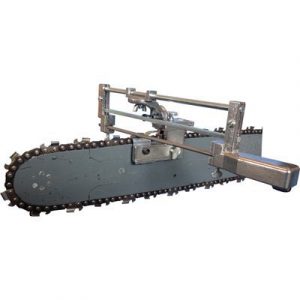
If you own a chainsaw, you understand the amount of sheer power packed in this mechanically powered cutting tool. When the chain wears out, you remain with three options: getting a new chain, taking the chain for re-sharpening at your local vendor, or, find yourself the best chainsaw sharpener and do the work yourself.
Buying the correct chainsaw sharpener that meets all your needs is easy business if you know what you are looking for. There are many things to consider, from the size of your chain down to the different brands of sharpeners that currently fill the market.
We took the initiative to look for some of the best chainsaw sharpeners out there that anyone can use, and we landed on a few. Out of all the hundreds of brands, we were able to narrow down to the best nine that had the qualities we were looking for.
The Buffalo Tools ECSS is a powerful electric chainsaw sharpener that weighs 7 pounds and measures 13.5 x 9.5 x 6.2 inches. It features a 4 ¼-inch x 1/8-inch grinding wheel that rotates at 4200 RPMs. We found this sharpener to work fast and is easy to use once set up on a solid bench, vise, or wall.
The Buffalo ECSS can be adjusted to fit the most popular chain sizes, and in our experience, you can be done sharpening in five minutes using this chain. Just make sure to put the correct setting on the lowest tooth and the setting will work for all the rest.
However…
The quality of this material is not the best in the world since some of the stops are made of plastic and look like they could break, so take care.
If you’re planning to use the instructions manual that comes with this sharpener for mounting purposes, we have to warn you, it will not be of much help since it contains very little information. Be sure to check out a few videos and reviews on how the sharpener works.
If you are mechanically inclined, however, you should have no trouble at all setting this tool up.
On another note…
The mounting holes are not shouldered at the bottom, therefore, we recommend using a pair of 5/16-inch fender washers to distribute the tool’s weight more evenly.
When sharpening, ensure the angle is right and that the grinder touches the teeth ever so slightly to avoid filing away too much material.
Lastly...
Wear protective gloves because the teeth will be very sharp. Overall, the Buffalo ECSS is a great machine for any homeowner to have in their arsenal.
The unit is affordable
Easy to use and cuts each tooth to the same length and angle
Adjustable to fit many chain sizes
Quick and powerful
The power switch is located in an unsafe spot on the machine
The mounting holes are not easily accessible and are not shouldered at the bottom
Some parts are made of poor quality material
The Oregon 410-120 is a decent bench or wall mounted chainsaw sharpener designed for occasional use. It comes in red and weighs 17 pounds. The kit features three grinding wheels, a quick check grinding template, and a dressing brick.
We noticed the sharpener to be solidly built and with great controls for sharpening different types of chains. It can sharpen both low and thick profiles, including ¼-inch and 3/8-inch chains as well as .325” and .404” chain pitches.
Inside, it’s fitted with a 3,500 RPM motor that rotates the grinding wheels at 0.4 horsepower. For safety purposes, the motor rotates in one direction only, which makes sharpening a bit slower. Check how this tool performs in this video.
According to our research…
The instructions that come with the Oregon 410-120 are not very useful and we recommend watching additional videos and reading reviews on how to best use the machine. This is because the guide comes installed vertically instead of horizontally for shipment and this is not mentioned in the instructions. You’ll also need additional mounting hardware.
As a result…
You’ll have to disassemble then reassemble the whole machine correctly before you can start using it. The casing that comes with the kit also looks cheap, but this should not break the deal in this case. The rest of the saw looks like it could easily outlast you if used properly and it works brilliantly when sharpening.
Solid construction
Includes 3 grinding wheels
Easy controls for sharpening various chain pitches
Not straight-forward to install
Low-quality packaging
Not portable
Motor moves in only one direction
The TruePower 01-0854 is an electric chainsaw sharpener with a futuristic design that definitely draws attention. It weighs 6.5 pounds and stands at 14 x 10 x 7 inches. It’s adjustable to fit all the various chain pitches and designs, and in our experience, it’s one of the easiest chainsaw sharpeners to use.
Inside, it has a powerful motor that can reach up to 4,200 RPMs. This rotates a durable carbide blade which then sharpens your chain. This kit comes with 4¼-inch x 1/8-inch grinding wheel. When it comes to its construction, it’s fitted with a dual handle to give you maximum control during sharpening.
Then again…
We thought the build looks a little below par since there are a lot of plastic parts, but for occasional use, this shouldn’t be a big deal. In the end, it does provide an accurate cut for every tooth, which is what matters.
Like we found with most chainsaw manuals, this one was goofy too and did not contain concise directions.
Therefore…
Be sure to source for more material online. Other than that, the TruePower 01-0854 is an affordable and extremely useful equipment to have on your side. It sets the angles perfectly and cuts quickly. The only conspicuous drawback was the lack of a depth gauge cutter that files the rakers. We recommend filing down these grooves with a flat file after sharpening every 4-5 teeth.
Quick and easy to set up
Powerful motor
Adjustable to fit all chain sizes
Works fast and efficiently
You’ll have to file the rakers separately with a flat file
Made of cheap material
Only suitable for occasional use
The Timberline Chainsaw Sharpener is a precision machine designed for chains with a .325-inch pitch. We noted it to be a very well made product, manufactured here in the U.S.A. Weighing at 1.15 pounds and measuring 6 x 4.2 x4 inches, it takes a very little amount of messing around to set it up.
It uses a high-grade tungsten carbide cutter that is turned manually by a handle. The tool works by clamping on the bar and allowing each tooth to be sharpened at a time.
It gets better…
One of the things we liked most about this cutter is that you can see the amount of material you are removing and make any necessary adjustments. This will cause your chain to last longer even with many sharpens.
It’s fitted with carbide guides that are fixed at a 30-degree angle. In case you require 25 and 35-degree guides, you’ll have to buy them separately.
The whole device arrives in a soft case with two zipper pockets.
During our tests…
We found this machine is simple to use and makes sure every tooth is razor sharp and the exact same length on either side of the bar without heating your saw. It takes a little time, but the effort does pay off in both time and money as compared to using a hand file or taking your chainsaw to the local dealer.
Nevertheless…
The carbide cutters look durable but brittle so do not twist or turn it backward. Also, if the machine moves a bit during use, use a chisel or screwdriver to score the smooth screws since they easily slip. Read Timberline’s instruction manuals to make sure you’re doing the right thing. Otherwise, the results will be wrong and it may even be dangerous.
Very well built
Allows you to see the amount of material removed over the life of the chain
Fast compared to other models in the range
Portable design with no motors or plastic parts
Carbide cutters are brittle
Designed for chainsaws with a .325 pitch size only
The Granberg Bar Mount Chainsaw Sharpener is a professional file and joint sharpener weighing only 1.7 pounds and measuring 12.5 x 7 x 1.5 inches. It’s designed to accommodate all types of file sizes for the most popular chain pitches. We used the calibrated swivel guide markings on the machine to set the correct angle easily.
The machine comes in a sturdy, cast aluminum and zinc-plated steel construction with thick walls and accessible dials that make it generally easier to use than most models. The grinder is made of quality material that we tested to sharpen various chainsaws to exact precision. The angles can be set anywhere from 0 to 40 degrees.
We found this machine to be extremely light and to work very efficiently. It would come in handiest to anyone who works in the woods or has to move from place to place frequently.
What’s more…
Besides sharpening the teeth, this tool also files the depth gauges according to your preferences.
To get the best cut, we recommend doing a bit of online research to see how it works and how to install the Granberg Bar Mount since the instructions that come with the kit are not very informative.
When installing, do not overtighten the screws since, in our experience, this could break the bracket. Other than that, this magnificent engineering feat can save you time and money.
Lightweight design
Adjustable to fit all standard pitch sizes
Sharpens teeth and files depth gauges at the same time
Quick and efficient
The wingnuts may loosen during use affecting the accuracy
More labor intensive compared to electric models
The XtremepowerUS 85W is an electric chainsaw sharpener driven by an 85W motor to provide up to 4,200 RPM. Even with all this, it still weighs only 5 pounds and measures 14.5 x 9.9 x 6.9 inches. It features a pivoting head and vice angles that can be adjusted anywhere from zero to 35 degrees on both sides (left and right).
We reckoned it to be a tool fit for the homeowner who loves a quick and efficient job or even for professionals who need to quickly sharpen several chains with different pitch sizes occasionally. It includes a brake handle for holding the chain in place and easy maneuvering.
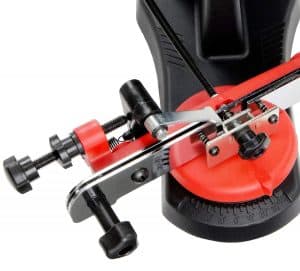 Above all…
Above all…
It’s affordable, portable, and does the job pretty well. During operation, we noticed the angles may get distorted and you might have to make little nuances to get the chain back on track. This can affect the overall precision of the cut by a small margin.
For the price, this tool is a go. It’s easy to use, great for small to medium operations, and safe to use.
The installation process, however, is not as easy as it should be and it may take you a while before you get used to snapping the chains in and out of the machine. It also arrived without the mounting bolts and screws so you’ll have to get these separately.
Easy to set up and little assembly needed
Easy to use with good and quick results
Affordable
Easily portable
Kit does not come with mounting bolts and these have to be purchased separately
Not as accurate as other electric models
The Stihl 2 in 1 Easy File Chainsaw Sharpener is an efficient hand file designed to sharpen chainsaws with a chain pitch of .325 inches. The file measures 8.4x 2 x 0.9 inches and weighs only 12.3 ounces, which means you can carry it around anywhere with you in the sturdy casing.
It comes with lines etched on the surface that make it easy to align with the bar and maintain the correct angles while sharpening.
For best results…
Look for the teeth with the most wear and count the number of strokes necessary to sharpen it then do the same for the rest. This chainsaw sharpener also files your depth gauges to the right depth at the same time.
In our experience, this file is able to get your chain razor-sharp with just a few strokes and is great even for novices who would like to try their hand at chainsaw sharpening.
Check out this video to learn tips and tricks for using this tool.
When talking about manual chainsaw sharpeners, it does not get any better than this. When used correctly, you’ll achieve razor sharpness, precise angles, and depths as we established in our tests.
For a novice, it may take up to 45-minutes to sharpen your chainsaw the first time, but this is bound to improve over time. When operating away from the workshop/home, using a vise to hold the chainsaw in place will give you the most efficient results.
Made from durable material
Easily portable
Economical
Difficult to maintain precise angles
Labor intensive
Requires sharpening skills
Designed for .325chain pitches only
The Granberg G1012XT is a professional chainsaw sharpener weighing just 1.8 pounds and measuring 9 x 4 x 7 inches in size. Inside, it’s fitted with a powerful grinder that spins at a whopping 24,000 RPMs. To withstand the high speeds, the grinder features a heat-resistant polycarbonate casing, a Kevlar® reinforced driver belt, and high-speed micro ball bearings.
Here’s what we thought:
This is a great product that works just as advertised. It features quality craftsmanship. Plus, it’s easy to set up and use. We found it very easy to set the correct sharpening angles and grinding depths by simply adjusting the dials and thumb nuts on this machine.
It’s also very portable and features an 8-inch power cord with alligator clips that can be readily hooked up to a 12-volt battery in case you are away from home.
In addition to that…
Once set up, the Granerg G1012XT takes only a few seconds to sharpen each tooth and file each raker--even for a novice. With time, sharpening your saw with this device should take you less than five minutes and save you a lot of money in the process, considering the tool’s affordability.
We recommend using their Kool-Grind stick lubricant which increases the lifespan of the stones and makes the grinding process smoother.
High-speed – with a 24,000 rpm grinding wheel and 12-volt input
Lightweight design for portability
Adjusts to fit all chain sizes
The unit gets hot when in use
The chain stop lever sticks out sometimes
The Timber Tuff CS-BWM is an electric chainsaw sharpener weighing 17.1 pounds and standing at 14.8 x 11.3 x 10.2 inches. The kit arrives with three grinding wheels with 1/8-inch, 3/16-inch, and ¼-inch diameters that provide crisp and quick sharpening.
Unlike some of the others, this chainsaw sharpener is easy to install and use by mounting it on a secure bench. It can also be mounted on a wall or other strong and flat surface.
But that’s not all…
Inside, it’s powered by a 110-volt, 60Hz motor that is able to spin the grinding wheels at 3,600 RPM. With all this power, this sharpener is able to sharpen chains from ¼-inches to ¾-inches. The Timber Tuff also features a transparent safety guide that allows you to clearly see what you’re working on a thermal overload protection in case things get too hot when working.
The device contains adjustment guides that are easy for anyone to comprehend and use, but we realized that they are a bit wanting in terms of precision.
Before mounting, you should know the base on the vise contains two small ball bearings that can fall out and get lost.
So, be careful.
After successful setup, however, we learned why this device has so many good reviews. It sharpens fast and accurately, maintaining all the angles in specific chains when set correctly.
Nonetheless…
When in use, we observed the motor rotates only in one direction which affects the quality of the sharpening on one side. And the safety shield is cumbersome to put on and take off. Also, the Timber Tuff can get quite hot during operation, so be sure to wear protective gloves. Other than that, this is a great product for the price, especially when used occasionally.
Designed for use with the most popular chain pitches
Easy to set up and use
Quick and efficient
Gets hot during operation
Safety guard is cumbersome to take off and put on
Motor rotates in one direction
Poor quality control
Typically…
Chainsaw blades are surrounded by a chain made up of cutters and depth gauges, (also called rakers). The cutters are the teeth that cut the workpiece, while the rakers are responsible for maintaining the depth which the cutters reach, hence making the process smooth and consistent. During maintenance, the rakers will need occasional filing and the teeth will need to be regularly maintained via sharpening.
To land on the best chainsaw sharpener for your needs, you’ll have to consider your preferences and go for what suits you best.
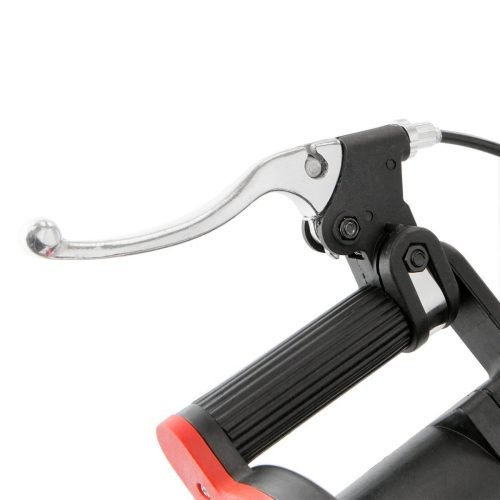
For instance:
If you rarely use your chainsaw, you can go for one of the cheap hand file sharpeners available if you do not mind the additional physical labor. If you sharpen your chainsaw/s regularly and want a more time efficient method, electric bench mounted sharpeners would be your best pick for getting your cutters back to their original condition.
Most of these can be adjusted to achieve different sharpening angles and accommodate different chainsaw sizes. They are also much faster compared to hand files and manual sharpening devices.
Lastly…
You can consider a manual sharpening unit that clips into the chainsaw’s guide bar and sharpens each tooth individually by turning a crank. Manual units have the advantages of portability and maintaining the precise sharpening angle, unlike when using a hand file. However, they are more labor-intensive and less efficient compared to electric units.
Chainsaws are convenient and powerful tools, but only when the rakers are smooth and the teeth are sharp. Otherwise, the chain will take more effort to cut through the wood that it would have otherwise buttered through.
This increases the risks of the chain getting stuck in the workpiece and causing a kickback. Kickback is a fast reverse reaction that jolts the guide bar towards the operator during operation and can be very dangerous. It occurs when the chain touches an object at the nose or tip of the guide bar while in operation, or when the wood pinches the saw chain in the cut–hence getting stuck.
And another thing…
A crisp, sharp chain will reduce the time it takes to make each cut while using less power. By cutting faster, you also benefit by saving money and energy when using a battery or gas powered chainsaw.
Finally…
Sharpening your chainsaw blade regularly reduces the rate of wear and tear with each subsequent use.
Let me explain…
When using a blunt blade, your cuts will be slower and less accurate, the blade will get stuck more often, and give more kickback before getting the job done. This is bound to cause a lot more wear and tear and dull the teeth even further. Keeping your chain sharpened regularly is arguably the most important chainsaw maintenance activity.
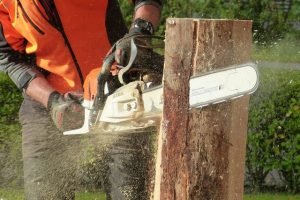 Do you want to learn how to sharpen your own saw?
Do you want to learn how to sharpen your own saw?
If you are a newbie at sharpening these chainsaw chains, even thinking about it can seem like too much already, but it’s easier than you might think at first. Chainsaw sharpeners are designed specifically to sharpen chainsaw blades using the least mental and physical effort.
Chainsaw sharpeners can be broadly categorized as either manual or electric. The manual tools include handheld sharpeners that are portable and straightforward to operate, though they are labor intensive. This makes them great only for occasional use.
On the other hand…
Electric sharpeners are convenient for more frequent use since they sharpen quickly and with very little effort once everything is set-up right.
If you do your cutting at home, an electric sharpener could work best. But, if you move around a lot, portability will be a factor, hence a sharpening kit may be more practical. It’s light and does not need electricity to operate.
We will look at the various types of sharpeners in more detail later in the article.
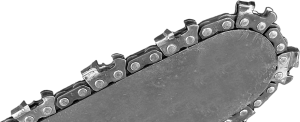
Chainsaw sharpeners have to be the right size to sharpen your chain correctly, and they range from small, medium, to large. Some sharpeners can only sharpen chains with specific pitch sizes while some are designed to sharpen multiple sizes by adjusting from ¼ to ¾ -inch. Most electric chainsaw sharpeners can be adjusted to fit any desired chain size.
Be sure to confirm that the sharpener you pick corresponds to the pitch of your chain.
When working with large sharpeners, it’s best to mount the tool on a firm surface for stability and accuracy. If you use your chainsaw frequently, the best move would be to go for a mountable sharpener over a hand-held one due to the improved speed and accuracy.
The amount of money you’re willing to spend will largely determine the type of sharpener you’ll end up with. Before overspending or underspending, however, you should consider how frequently you plan to use the sharpener.
Yet…
If you only need it for occasional use, then look for the most affordable but quality model. But if you’ll use it frequently, it’s advisable to get a tool that can handle the heavy use in terms of durability and speed.
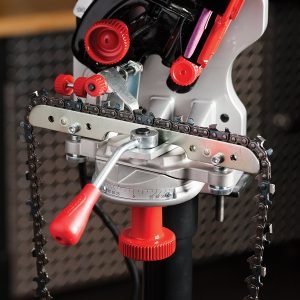 Build quality
Build qualityWhen buying any product, the quality of the materials used to assemble it should always be a concern. Well-built appliances last longer, are safer, and more accurate.
This cannot be more true for chainsaw sharpeners.
Therefore, check the grinding disks and files to see if they can withstand heavy-duty use and be sure to watch online videos to see how different models perform under pressure.
Chainsaws are dangerous tools because they have razor-sharp teeth and can also be moved around freely.
As a result…
It’s important to look for the necessary safety features such as safety guards. Especially when looking to buy motor-powered sharpeners.
If you move a lot when using your chainsaw–such as when working in the woods, or from place to place–the portability of your sharpener will be a huge concern for you. Portable sharpeners are normally lightweight and can be connected to a 12-volt battery in case they need electricity to work.
As shown above, there are many factors that work in combination to dull the blade in your chainsaw.
Weirdly…
One of the biggest culprits is the dirt and debris the machine collects when in storage. Irrespective of the cause, blades should be sharpened as soon as they get blunt.
Which begs the question…
How soon is soon enough for sharpening your blades? Here are a few pointers to guide you:
Chainsaws are designed to self-feed, meaning they get deeper with every subsequent cut stroke. When yours stops self-feeding, hence requiring you to apply pressure, then it might be time for sharpening.
When your blades are sharp, they tend to produce clean and square wood chip kinds of debris. If you notice your saw producing fine debris, like saw-dust, sharpening may do the trick.
It might look great, but trust me, when your chainsaw blades have a gleam; it’s usually a sign of too much wear and tear, which simply translates to blunt teeth. Be sure to look out for this sign and get your sharpener as soon as you notice it.
It does not stop there…
Continued use of your chainsaw even after the signs mentioned above have manifested themselves will lead to faster deterioration of the tool. Take sharpening the blades as part of the chainsaw’s regular maintenance and it will serve you for a long time.
As with any task, you’ll need the knowledge and the right tools to do the job right.
Part of keeping a chainsaw effective and well-maintained is by sharpening its chain whenever it’s required. This will ensure your saw is working to its full potential, will not undergo unnecessary wear and tear, and will also be safe to use.
Regular sharpening also prolongs the lifespan of your chainsaw by not overworking the engine, saving time and lowering the risks of jamming, kickbacks, and flying debris. While there are different ways to achieve this, the most efficient one is using dedicated chainsaw sharpeners.
These machines come in all shapes, colors, and sizes, ranging from manual and electric sharpeners to hydraulic ones and even more. Therefore, you can find anything that fits your needs without making a dent in your wallet. Chainsaw sharpeners can be categorized as follows:
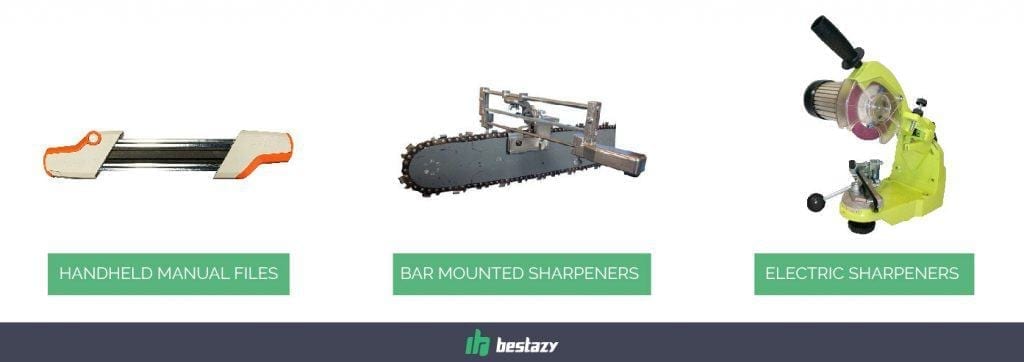
As the name suggests…
These are simply small, rounded, handheld files designed to sharpen one chainsaw tooth at a time by running it over the tip of the chain. Today, there are many small and cheap electric sharpeners available, rendering most hand files useless since they take too much time and effort to complete the job. However, they still come in handy, especially for those in need of mobility, not to mention the affordable prices.
When using files, keep in mind different chains require file sizes of different diameters. Most manufacturers sell these in sets. Check to see if the files match the pitch of your chain. Also, it’s difficult to get a uniform sharpening on all teeth on the blade due to its manual nature. Users are advised not to distort the cutting angles of their machines while using hand files.
Bar mounted chainsaw sharpeners are kind of between the handheld and electric models, in that they are not powered by a motor, but they are more efficient compared to hand files.
These tools fit onto the bar guide on your chainsaw, so the teeth can be run through for sharpening by using knobs that can set both the filing angle and depth.
Most will need a flat and stable mounting platform for the best performance such as a table, wall, or bench. Once set up, most bar mounted sharpeners have a crank system that moves the chain through the sharpener.
It’s true…
These type of sharpeners are very efficient and accurate compared to hand files and they cost less than electric models. However, they still need to be mounted on another surface and are more labor intensive compared to electric models. Learn more about Electric Knife Sharpener and Electric Pencil Sharpener.
The electric chainsaw is the fastest, more modernized version of the chainsaw sharpener. This type is loved by professionals and enthusiasts alike due to its speed and ease of use. All you need to do is hook it to your chainsaw bar guide, make the necessary adjustments, and power it on.
Most electric sharpeners are designed to sharpen a range of different chain sizes. This is a huge advantage over the handheld and bar mounted models. It’s also easy to get a uniform and accurate sharpening every time with these sharpeners.
Therefore…
If you need to sharpen your chainsaw regularly, you cannot go wrong with a good electric sharpener.
However, due to how they are built and how they work, electric sharpeners should be used while wearing the correct protective equipment such as helmets, ear protection, goggles, and gloves. These sharpeners also tend to be more expensive on average compared to other types, but not always.
Can you really afford to not own a chainsaw sharpener if you already own a chainsaw machine?
I think not.
Fortunately, we found the best chain sharpener we think will work great for most people. After all our testing and research was over with, here’s the sharpener that wowed us the most:
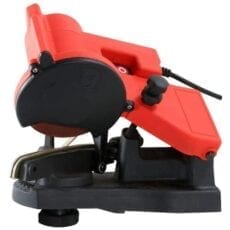
When the chain of your chainsaw wears out, you only have three options: getting a new chain, taking the chain for re-sharpening at your local vendor, or, find yourself the best chainsaw sharpener and do the work yourself.
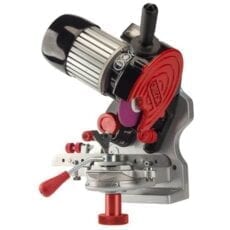
When the chain of your chainsaw wears out, you only have three options: getting a new chain, taking the chain for re-sharpening at your local vendor, or, find yourself the best chainsaw sharpener and do the work yourself.
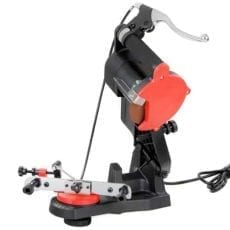
When the chain of your chainsaw wears out, you only have three options: getting a new chain, taking the chain for re-sharpening at your local vendor, or, find yourself the best chainsaw sharpener and do the work yourself.
Depending on the type of chain on your saw, the filing angles may vary widely. An easy way to set the cutter to the right angles is using filing gauge which automatically set the correct angles by following the instructions.
When your chainsaw is not cutting straight, it usually means the teeth in your saw wore out unevenly. This means the side with the longer teeth will cut a larger chunk of wood than the shorter teeth, resulting in a skewed cut.
If the blades are cutting more to the right, it means the left teeth are longer and the opposite is true. In such a scenario, sharpen the side with the longer teeth to correct the inaccuracy.
If the blade is sharp and the teeth are even but your chain is not cutting, the most probable cause is the gauges, also called rakers, are too high and need to be lowered.
Rakers are the spaces shaped like a shark’s fin next to each tooth on the saw. It controls the depths of the teeth while cutting through wood.
When sharpening the chain, the teeth reduce both in length and height over time. As a result, the rakers also need to be lowered using a flat file every once in a while to correct this.
Two strokes for each gauge is normally enough. You do not want to lower them too much since this will cause the machine to cut larger chunks of wood than desired increasing the risks of jamming and kickbacks.
Chainsaw blades dull over time, even when in storage and hence may need regular sharpening, say once every three months when not in use. However, if you use a chainsaw regularly, it’s recommended you sharpen the chain every time you refuel for just a few minutes. It’s easier to sharpen often for a little while rather than waiting for things to get completely out of hand.
You’ll know it’s time to replace your chainsaw chain when the longest point in the cutting teeth gets less than 4mm long or in case you notice any cracks and fractures in the chain.
Always start by looking for the shortest cutter and set the setting to match this size. This way, all the teeth will be the same length after sharpening.
While using a hand file, file the teeth with smooth strokes moving away from you.
Always wear protective material when using an electric or bar mounted sharpener.
To reduce the amount of wear and tear and for the most accurate results, always try to file away as little material as you can.
